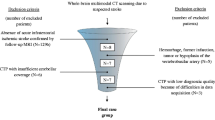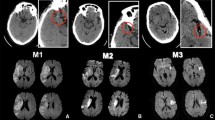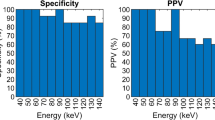Abstract
We investigated the utility of computed tomographic (CT) perfusion (CTP) with 64-row multi-detector row CT (MDCT) to diagnose acute infarction and ischemic penumbra. We reviewed 58 clinical cases with acute ischemic stroke with CTP, compared the size of the area with long mean transit time (MTT) to that with abnormal intensity in magnetic resonance (MR) diffusion-weighted imaging (DWI) to diagnose penumbra, and compared the size of the area with reduced cerebral blood volume (CBV) in CTP to that in MR DWI to evaluate sensitivity for infarction. The total sensitivity of MTT to acute ischemic lesions was 81% (47/58). Sensitivity of MTT to segmental lesions was 100% (42/42) and for spot and focal lesions, 31% (5/16). In 13 patients, penumbra was diagnosed as lesions mismatched between MTT in CTP and MR DWI. When we regarded a lesion with decreased CBV as infarction, the sensitivity of CBV to segmental lesions was 85% (11/13), and the sensitivity to small infarction was 14% (4/28). Use of 64-row MDCT improves coverage and radiation exposure in head CTP. The combination of plain CT, CT angiography, and CTP with MDCT can demonstrate all segmental ischemic lesions and most large segmental infarctions, and their combined application is useful in considering indication and contraindication for thrombolysis. The problem of low sensitivity for small lesions remains, and MR DWI may be required to assess small infarctions when findings from combined plain CT, CT angiography, and CTP are negative in patients with suspected acute brain stroke.


Similar content being viewed by others

References
Schellinger PD, Fiebach JB, Mohr A, Ringleb PA, Jansen O, Hacke W (2001) Thrombolytic therapy for ischemic stroke–a review. Part I—Intravenous thrombolysis. Crit Care Med 29:1812–1818
Roberts HC, Roberts TP, Smith WS, Lee TJ, Fischbein NJ, Dillon WP (2001) Multisection dynamic CT perfusion for acute cerebral ischemia: the “toggling-table” technique. AJNR Am J Neuroradiol 22:1077–1080
Wintermark M, Reichhart M, Thiran JP, Maeder P, Chalaron M, Schnyder P, Bogousslavsky J, Meuli R (2002) Prognostic accuracy of cerebral blood flow measurement by perfusion computed tomography, at the time of emergency room admission, in acute stroke patients. Ann Neurol 51:417–432
Rempp KA, Brix G, Wenz F, Becker CR, Gückel F, Lorenz WJ (1994) Quantification of regional cerebral blood flow and volume with dynamic susceptibility contrast-enhanced MR imaging. Radiology 193:637–641
Kikuchi K, Murase K, Miki H, Yasuhara Y, Sugawara Y, Mochizuki T, Ikezoe J, Ohue S (2002) Quantitative evaluation of mean transit times obtained with dynamic susceptibility contrast-enhanced MR imaging and with (133)Xe SPECT in occlusive cerebrovascular disease. AJR Am J Roentgenol 179:229–235
Kanal E, Barkovich AJ, Bell C, Borgstede JP, Bradley WG Jr, Froelich JW, Gilk T et al (2007) ACR guidance document for safe MR practices: 2007. AJR Am J Roentgenol 188:1447–1474
Wang YF, Tsirka SE, Strickland S, Stieg PE, Soriano SG, Lipton SA (1995) Tissue plasminogen activator for acute ischemic stroke. The National Institute of Neurological Disorders and Stroke rt-PA Stroke Study Group. N Engl J Med 333:1581–1587
Lev MH, Segal AZ, Farkas J, Hossain ST, Putman C, Hunter GJ, Budzik R et al (2001) Utility of perfusion-weighted CT imaging in acute middle cerebral artery stroke treated with intra-arterial thrombolysis: prediction of final infarct volume and clinical outcome. Stroke 32:2021–2028
Schellinger PD, Fiebach JB, Hacke W (2003) Imaging-based decision making in thrombolytic therapy for ischemic stroke: present status. Stroke 34:575–583
Eastwood JD, Lev MH, Azhari T, Lee TY, Barboriak DP, Delong DM, Fitzek C et al (2002) CT perfusion scanning with deconvolution analysis: pilot study in patients with acute middle cerebral artery stroke. Radiology 222:227–236
Wintermark M, Fischbein NJ, Smith WS, Ko NU, Quist M, Dillon WP (2005) Accuracy of dynamic perfusion CT with deconvolution in detecting acute hemispheric stroke. AJNR Am J Neuroradiol 26:104–112
Astrup J, Siesjö BK, Symon L (1981) Thresholds in cerebral ischemia—the ischemic penumbra. Stroke 12:723–725
Soares BP, Dankbaar JW, Bredno J, Cheng S, Bhogal S, Dillon WP, Wintermark M (2009) Automated versus manual post-processing of perfusion-CT data in patients with acute cerebral ischemia: influence on interobserver variability. Neuroradiol 51:445–451
Nabavi DG, Cenic A, Craen RA, Gelb AW, Bennett JD, Kozak R, Lee TY (1999) CT assessment of cerebral perfusion: experimental validation and initial clinical experience. Radiology 213:141–149
Heiss WD, Grond M, Thiel A, von Stockhausen HM, Rudolf J (1997) Ischaemic brain tissue salvaged from infarction with alteplase. Lancet 349:1599–1600
Wintermark M, Flanders AE, Velthuis B, Meuli R, van Leeuwen M, Goldsher D, Pineda C et al (2006) Perfusion-CT assessment of infarct core and penumbra: receiver operating characteristic curve analysis in 130 patients suspected of acute hemispheric stroke. Stroke 37:979–985
Hoeffner EG, Case I, Jain R, Gujar SK, Shah GV, Deveikis JP, Carlos RC et al (2004) Cerebral perfusion CT: technique and clinical applications. Radiology 231:632–644
Schmülling S, Grond M, Rudolf J, Heiss WD (2000) One-year follow-up in acute stroke patients treated with rtPA in clinical routine. Stroke 31:1552–1554
Cocho D, Belví R, Martí-Fàbregas J, Bravo Y, Aleu A, Pagonabarraga J, Molina-Porcel L et al (2006) Does thrombolysis benefit patients with lacunar syndrome? Eur Neurol 55:70–73
Suzuki K, Morita S, Masukawa A, Machida H, Ueno E (2010) Diagnosing a large slowly enhanced cerebral aneurysm using 4-dimensional multiphase dynamic contrast-enhanced CT angiography. Jpn J Radiol (in press)
Hirata M, Sugawara Y, Fukutomi Y, Oomoto K, Murase K, Miki H et al (2005) Measurement of radiation dose in cerebral CT perfusion study. Radiat Med Mar 23(2):97–103
Sasaki M, Kudo K, Oikawa H (2006) CT perfusion for acute stroke: current concepts on technical aspects and clinical applications. Elsevier, New York
Conflicts of interest statement
We declare that we have no conflict of interest.
Author information
Authors and Affiliations
Corresponding author
Rights and permissions
About this article
Cite this article
Suzuki, K., Morita, S., Masukawa, A. et al. Utility of CT perfusion with 64-row multi-detector CT for acute ischemic brain stroke. Emerg Radiol 18, 95–101 (2011). https://doi.org/10.1007/s10140-010-0905-8
Received:
Accepted:
Published:
Issue Date:
DOI: https://doi.org/10.1007/s10140-010-0905-8



